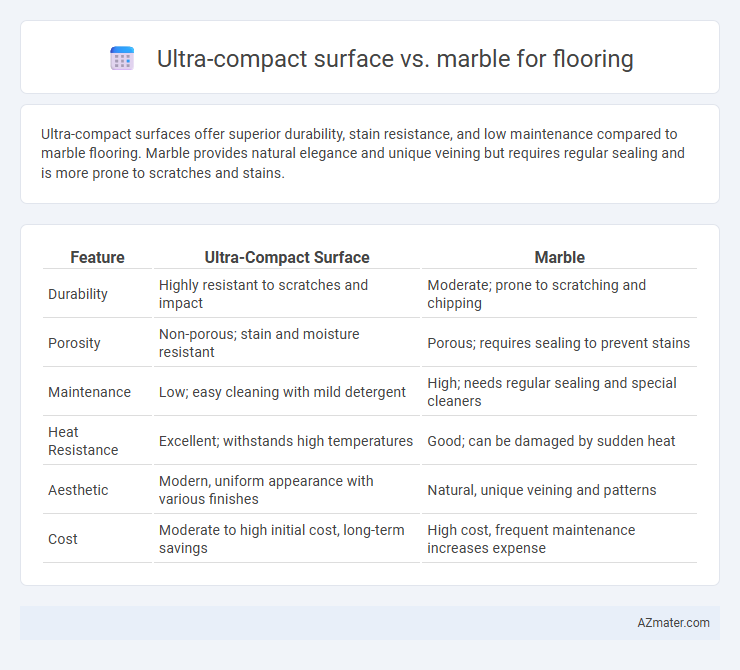Ultra-compact surfaces offer superior durability, stain resistance, and low maintenance compared to marble flooring. Marble provides natural elegance and unique veining but requires regular sealing and is more prone to scratches and stains.
Table of Comparison
| Feature | Ultra-Compact Surface | Marble |
|---|---|---|
| Durability | Highly resistant to scratches and impact | Moderate; prone to scratching and chipping |
| Porosity | Non-porous; stain and moisture resistant | Porous; requires sealing to prevent stains |
| Maintenance | Low; easy cleaning with mild detergent | High; needs regular sealing and special cleaners |
| Heat Resistance | Excellent; withstands high temperatures | Good; can be damaged by sudden heat |
| Aesthetic | Modern, uniform appearance with various finishes | Natural, unique veining and patterns |
| Cost | Moderate to high initial cost, long-term savings | High cost, frequent maintenance increases expense |
Introduction to Ultra-Compact Surface and Marble Flooring
Ultra-compact surfaces, made from a high-tech blend of natural minerals and advanced resins, offer exceptional durability, resistance to scratches, heat, and stains, making them ideal for high-traffic flooring areas. Marble flooring, prized for its natural elegance and unique veining, is a timeless choice but requires regular maintenance and sealing to protect against staining and wear. Comparing ultra-compact surfaces to marble highlights trade-offs between low maintenance with ultra-compact material and the classic, luxurious aesthetic provided by natural marble.
Key Material Composition and Properties
Ultra-compact surfaces are engineered primarily from inorganic components such as glass, quartz, porcelain, and oxides, resulting in exceptional hardness, low porosity, and high resistance to scratches, stains, and heat. Marble, composed mainly of calcite (calcium carbonate), offers a natural crystalline structure with a porous surface that is more susceptible to etching, staining, and abrasion, requiring regular sealing for maintenance. The dense and homogenous composition of ultra-compact surfaces makes them highly durable and suitable for high-traffic flooring, while marble provides unique aesthetic veining but demands more careful upkeep due to its softer, more reactive mineral properties.
Aesthetic Appeal: Ultra-Compact Surface vs Marble
Ultra-compact surfaces offer a sleek, modern aesthetic with consistent patterns and colors, making them highly versatile for contemporary flooring designs. Marble provides a timeless, natural elegance with unique veining and color variations that create a luxurious and classic appeal. The choice between ultra-compact surfaces and marble ultimately depends on whether a uniform, minimalist look or a rich, organic texture is desired for the flooring.
Durability and Lifespan Comparison
Ultra-compact surfaces demonstrate exceptional durability, resisting scratches, stains, and impact better than natural marble, which is more prone to chipping and etching over time. The lifespan of ultra-compact flooring often exceeds 25 years with minimal maintenance, whereas marble typically requires regular sealing and refinishing to preserve its appearance and structural integrity. Ultra-compact materials maintain their aesthetic appeal longer under high-traffic conditions, making them a superior choice for durable flooring solutions.
Maintenance Requirements and Ease of Cleaning
Ultra-compact surfaces offer superior resistance to stains, scratches, and heat, making maintenance minimal and cleaning straightforward with just mild soap and water. Marble flooring, while elegant, requires regular sealing to prevent etching and staining, and it demands specialized cleaning products to avoid damage from acids or abrasives. Choosing ultra-compact materials significantly reduces long-term upkeep compared to the high-maintenance nature of marble floors.
Stain and Scratch Resistance
Ultra-compact surfaces demonstrate superior stain and scratch resistance compared to marble, making them ideal for high-traffic flooring applications. Engineered with dense, non-porous materials, ultra-compact floors resist acidic spills, oils, and abrasive impacts without discoloration or surface damage. Marble, while aesthetically appealing, is more susceptible to etching and scratching due to its porous calcium carbonate composition, requiring regular sealing and maintenance for durability.
Installation Process and Flexibility
Ultra-compact surfaces offer a faster, lighter installation process compared to marble, as they are thinner and easier to handle, reducing labor time and costs. Their flexibility allows for seamless mounting on uneven substrates and compatibility with underfloor heating systems, whereas marble requires careful leveling and can be prone to cracking. The high durability and water resistance of ultra-compact materials eliminate extensive sealing and maintenance typical of marble flooring installations.
Cost Analysis: Ultra-Compact Surface vs Marble
Ultra-compact surfaces generally offer a lower cost per square foot compared to natural marble, making them a budget-friendly choice for flooring projects. Installation expenses for ultra-compact surfaces tend to be more predictable due to their uniform thickness and ease of handling, whereas marble often requires skilled labor and additional sealing. Over time, ultra-compact flooring typically incurs lower maintenance costs, as it resists stains and scratches better than marble, which demands periodic polishing and sealing to maintain its appearance.
Eco-Friendliness and Sustainability Factors
Ultra-compact surfaces, made from natural minerals and recycled materials, offer superior eco-friendliness compared to traditional marble, which involves intensive quarrying and higher energy consumption. These innovative materials require less water and emit fewer greenhouse gases during production, contributing to sustainability in flooring. Choosing ultra-compact surfaces supports circular economy principles with longer durability and easier recyclability than marble.
Best Applications and Recommended Use Cases
Ultra-compact surfaces excel in high-traffic commercial spaces and modern kitchens due to their exceptional durability, resistance to scratches, and low porosity, making them ideal for heavy-use flooring applications. Marble is preferred in luxury residential settings and elegant hotel lobbies where aesthetics and natural veining create a sophisticated ambiance, though it requires more maintenance and is prone to etching. For best results, ultra-compact surfaces suit industrial and contemporary environments, while marble enhances classic or formal interiors demanding visual opulence.

Infographic: Ultra-compact surface vs Marble for Flooring
 azmater.com
azmater.com